
The Super Nintendo Entertainment System, commonly shortened to Super Nintendo, Super NES or SNES, is a 16-bit home video game console developed by Nintendo that was released in 1990 in Japan and South Korea, 1991 in North America, 1992 in Europe and Oceania and 1993 in South America. In Japan, it is called the Super Famicom (SFC). In South Korea, it is called the Super Comboy and was distributed by Hyundai Electronics. The system was released in Brazil on August 30, 1993, by Playtronic. Although each version is essentially the same, several forms of regional lockout prevent cartridges for one version from being used in other versions.

A game controller, gaming controller, or simply controller, is an input device or input/output device used with video games or entertainment systems to provide input to a video game. Input devices that have been classified as game controllers include keyboards, mice, gamepads, and joysticks, as well as special purpose devices, such as steering wheels for driving games and light guns for shooting games. Controllers designs have evolved to include directional pads, multiple buttons, analog sticks, joysticks, motion detection, touch screens and a plethora of other features.
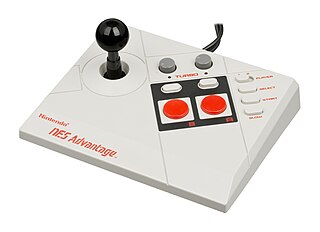
The NES Advantage is an arcade style controller manufactured by Asciiware and released by Nintendo for the Nintendo Entertainment System in 1987. The device is meant to rest on a flat surface at a comfortable level, such as a tabletop or the floor, with the player seated behind it. This way, it can be used like an arcade game joystick—with the left hand using the joystick and the right hand operating the buttons.
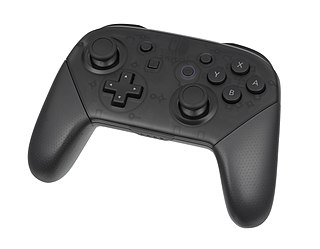
A gamepad is a type of video game controller held in two hands, where the fingers are used to provide input. They are typically the main input device for video game consoles.
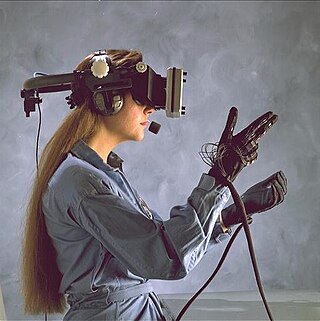
A wired glove is an input device for human–computer interaction worn like a glove.

The Dual Analog Controller is Sony's first handheld analog controller for the PlayStation, and the predecessor to the DualShock; the first analog controller was the PlayStation Analog Joystick (SCPH-1110).
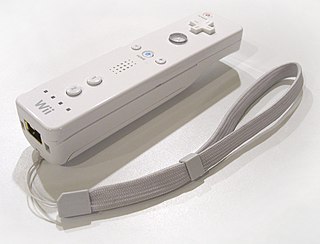
The Wii Remote, also known colloquially as the Wiimote, is the primary game controller for Nintendo's Wii home video game console. An essential capability of the Wii Remote is its motion sensing capability, which allows the user to interact with and manipulate items on screen via motion sensing, gesture recognition, and pointing using an accelerometer and optical sensor technology. It is expandable by adding attachments. The attachment bundled with the Wii console is the Nunchuk, which complements the Wii Remote by providing functions similar to those in gamepad controllers. Some other attachments include the Classic Controller, Wii Zapper, and the Wii Wheel, which was originally released with the racing game, Mario Kart Wii.

The Nintendo 64 controller is the standard game controller for the Nintendo 64 home video game console. It was first manufactured and released by Nintendo on June 23, 1996, in Japan; in September 29, 1996, in North America; and March 1, 1997, in Europe. It is the successor to the Super Nintendo controller and is designed in an "M" shape and features 10 buttons, a "Control Stick", and a D-pad.

The R-Zone is a portable game console developed and manufactured by Tiger Electronics. The R-Zone was shown at the American International Toy Fair in February 1995, and was released later that year. The R-Zone was panned by critics, and was also a commercial disaster, with its lifespan lasting only two years before being discontinued in 1997. Although the R-Zone was not designed to compete directly with any other handhelds, it marked Tiger Electronics' first multi-game entry into the portable electronic game market.

The Classic Controller is a game controller produced by Nintendo for the Wii home video game console. While it later featured some compatibility with the Wii U console, the controller was ultimately succeeded by the Wii U Pro Controller. In April 2014, Nintendo discontinued production of both the Classic Controller and Classic Controller Pro.
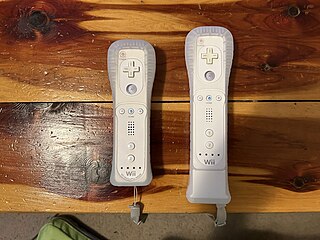
In computing, a motion controller is a type of input device that uses accelerometers, gyroscopes, cameras, or other sensors to track motion.
Nintendo 64 accessories are first-party Nintendo hardware—and third-party hardware, licensed and unlicensed. Nintendo's first-party accessories are mainly transformative system expansions: the 64DD Internet multimedia platform, with a floppy drive, video capture and editor, game building setup, web browser, and online service; the controller plus its own expansions for storage and rumble feedback; and the RAM-boosting Expansion Pak for big improvements in graphics and gameplay. Third-party accessories include the essential game developer tools built by SGI and SN Systems on Nintendo's behalf, an unlicensed SharkWire online service, and unlicensed cheaper counterparts to first-party items. In the fifth generation of video game consoles, the Nintendo 64 had a market lifespan from 1996 to 2002.

In computing, an input device is a piece of equipment used to provide data and control signals to an information processing system, such as a computer or information appliance. Examples of input devices include keyboards, computer mice, scanners, cameras, joysticks, and microphones.
Since the release of the Nintendo Wii, many aesthetic, ergonomic and functional accessories have been developed by third parties for the console’s controller, the Wii Remote.

The Wand is a line of game controllers released by Nyko as third-party alternatives to the official Nintendo Wii Remote. The original Wand duplicated the functionality of the Wii Remote, while the updated Wand+ added internal replication of the Wii MotionPlus for more advanced motion sensing, similar to Nintendo's later Wii Remote Plus. The Wand series also adds additional functionality through the use of a proprietary extension of the standard Wii Remote expansion port.
VPL Research was one of the first companies that developed and sold virtual reality products. It was founded by computer scientist Jaron Lanier in 1984. "VPL" stood for "Virtual Programming Languages". In 1990, VPL Research filed for bankruptcy and in 1999 all of its patents were bought by Sun Microsystems.

The Atari CX40 joystick was the first widely used cross-platform game controller. The original CX10 was released with the Atari Video Computer System in 1977 and became the primary input device for most games on the platform. The CX10 was replaced after a year by the simpler and less expensive CX40. The addition of the Atari joystick port to other platforms cemented its popularity. It was the standard for the Atari 8-bit computers and was compatible with the VIC-20, Commodore 64, Commodore 128, MSX, and later the Atari ST and Amiga. Third-party adapters allowed it to be used on other systems, such as the Apple II, Commodore 16, TI-99/4A, and the ZX Spectrum.

A virtual reality game or VR games is a video game played on virtual reality (VR) hardware. Most VR games are based on player immersion, typically through head-mounted display unit or headset with stereoscopic displays and one or more controllers.

The Xbox Adaptive Controller (XAC) is a video game controller designed by Microsoft for Windows PCs and the Xbox One and Xbox Series X/S video game consoles. The controller was designed for people with disabilities to help make user input for video games more accessible.



















